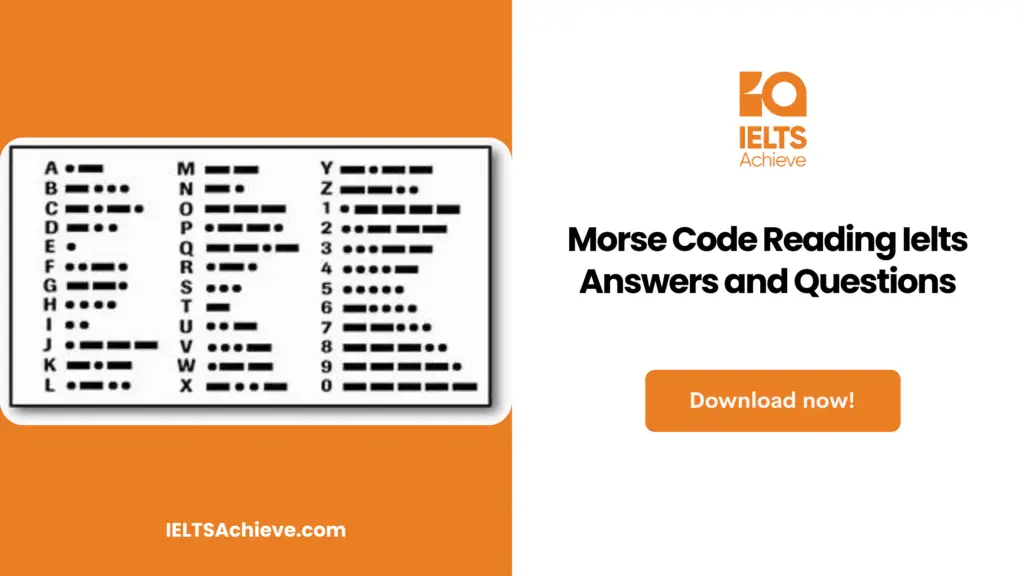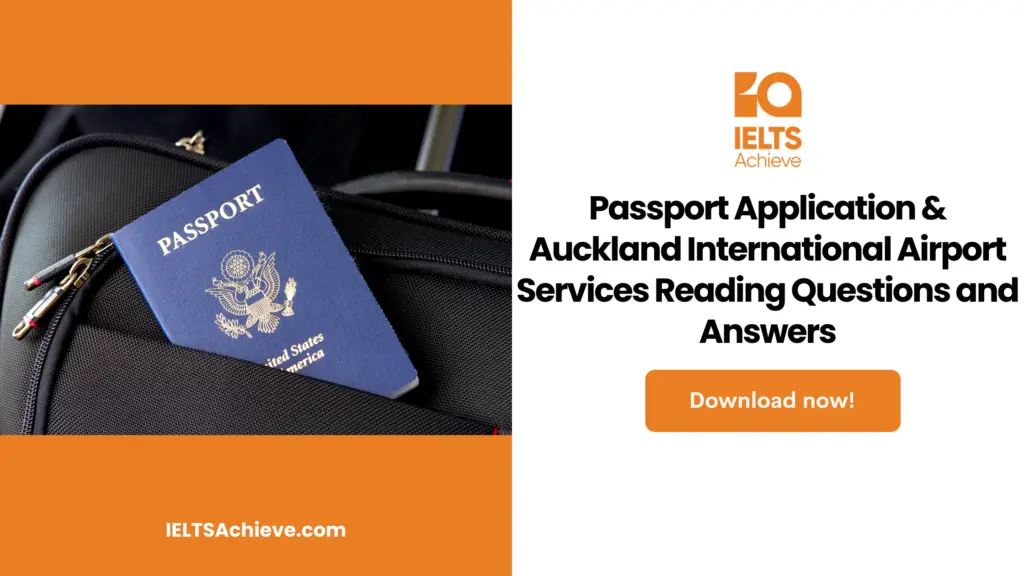The Blog post contains the following IELTS Reading Questions:
- IELTS reading matching headings
- IELTS reading true false not given
- IELTS reading multiple choice questions
Stay informed and prepared for success – Explore our comprehensive Reading Test Info page to get valuable insights, exam format details, and expert tips for mastering the IELTS Reading section.
IELTS Reading Passage: Morse Code

Morse Code
A new satellite-based system is being implemented to replace Morse code for sending distress calls at sea. Since 1992, when the Global Maritime Distress and Safety System was established, nations have been gradually retiring their Morse equipment with similarly solemn (though less lyrical) farewells as the world’s shipping community transitions to the new satellite-based system. Many people consider February 1st to be the end of an era, as that is when the transition to GMDSS must be completed. Even while some people (amateur radio operators, spies, and some military personnel) will continue to utilize dots and dashes after the transfer to GMDSS, this will be the end of the final major international usage of Morse.
However, the code has a solid background behind it. According to legend, Samuel Morse came up with the idea for Morse code while he was on a ship crossing the Atlantic, which is fitting for a technology so closely connected with radio operators on doomed vessels. Morse, who was a painter and occasional inventor at the time, became fascinated with the concept of creating the electric telegraph after hearing about recent developments in electrical theory from another passenger on the ship. For the better part of a century, other innovators had been striving to achieve the same goal. Morse’s success and legacy as the telegraph’s “father” might be attributed in part to his dogged determination; it took, for example, 12 years for him to gain funding from Congress to build his first telegraph line.
Morse’s design for the electric telegraph was much more straightforward than its competitors; all it took to transmit a message was a “key” (basically a spring-loaded switch), a “sounder” (an audible signal), and a wire. Morse’s technology was straightforward, but it required operators to master a unique system of dots and dashes. Morse didn’t set out to depict letters using combinations of dots and dashes. While crossing the Atlantic, he sketched up his first code, which used dots and dashes to represent the numbers 0 through 9. Morse proposed that messages be made up of sequences of numbers that would be mapped to words and phrases in a unique numerical lexicon. Later, however, Morse gave up on that plan in favor of developing the Morse alphabet with his friend and colleague Alfred Vail. This system allowed for the individual letters of words to be represented by dots and dashes. Morse’s telegraph appeared insurmountably difficult at first because of the necessity to master this complicated-looking code, especially in light of previous, more user-friendly designs. With Cooke and Wheatstone’s telegraph, for instance, five needles were employed to select individual letters from a diamond-shaped grid. This meant that anyone could use the telegraph, but it also necessitated the use of five lines to connect each telegraph station. When using Morse’s telegraph, only one was required.
As the use of electric telegraphy spread rapidly in the early 1850s, the Morse telegraph soon became the standard. In 1851, it was officially recognized as the European standard, paving the way for seamless cross-border communication via telegraph. (Great Britain opted not to update their language to account for regional variations and foreign influences.) By this point, Morse code was being used; however, it still relied on needle telegraphs for a few characters, which led to the ongoing division between American and International Morse.
When transmitting data via international underwater cables, dots and dashes were represented by the leftward and rightward movement of a light beam reflected by a tiny spinning mirror. At the same time, a new telegraphic society was developing, complete with its own slang and a social order based on the operators’ Morse code speed. In large cities, the highest-paying employment goes to first-class operators who can send and receive at speeds of up to 45 words per minute and hence handle press traffic. Slow, incompetent rural operators, many of whom only operated the wires on the side, were at the bottom of the totem pole. However, as their proficiency in Morse code increased, rural operators discovered that their newfound expertise was a ticket to higher compensation in urban settings. As a result, telegraphers quickly became a significant part of the newly formed middle class. Work in telegraphy was likewise seen as acceptable for women. As early as 1870, women made up a third of the workforce at the Western Union branch in New York City.
Morse personally bid farewell to the international network of telegraphists he had helped create in a dramatic ceremony in 1871. More than 650,000 miles of telegraph line and 30,000 miles of underwater cable were pulsating with Morse code and 20,000 towns and villages were connected to the worldwide network by the time of his death in 1872. The telegraph was once referred regarded as the “instantaneous highway of the idea,” much like the Internet is today.
However, the telegraph’s time as a cutting-edge technology was coming to an end by the 1890s, thanks to the development of the telephone and the advent of automatic telegraphs, forerunners of the teleprinter, which did not necessitate any specialized training to use. But another innovation, wireless, was going to offer Morse code a second chance. Radiotelegraphy’s potential maritime applications became immediately obvious after its creation by Guglielmo Marconi in 1896. Previously, ships were unable to talk to each other or the shore when the weather was bad or they were too far away to see each other. Marconi used Morse code to communicate with an Italian cruiser located 19 kilometers (12 miles) away in 1897. In 1899, a lightship in the Dover Straits reported the grounding of the steamship Elbe, marking the first maritime rescue after a distress call sent via the radiotelegraph.
Unlock your full potential in the IELTS Reading section – Visit our IELTS Reading Practice Question Answer page now!
Recommended Questions:
Renewable Energy IELTS Reading Question with Answer
Morse Code IELTS Reading Questions
Questions 1-7
Reading passage has seven paragraphs, A-G. Choose the correct heading for paragraph A-G from the list of headings below. Write the correct number, i-ix, in boxes 1-7 on your answer sheet.
i. Creating electricity.
ii. The emergence of several job opportunities.
iii. Modification of the Morse code.
iv. Morse code’s creation.
v. For the code, there is both a standard and some room for deviation.
vi. Radio operators are essential.
vii. The benefits of Morse’s innovation.
viii. Morse code’s use on ships increased as new tools became available.
ix. Morse code’s global impact
- Paragraph A –
- Paragraph B –
- Paragraph C –
- Paragraph D –
- Paragraph E –
- Paragraph F –
- Paragraph G –
Ready to conquer Matching Headings questions? Click here to learn essential tips and techniques for matching headings accurately to paragraphs or sections in the IELTS Reading section.
Questions 8-12
Do the following statements agree with the claims of the writer in Reading Passage?
In boxes 8-12 on your answer sheet, write.
TRUE if the statement is True
FALSE if the statement is false
NOT GIVEN If the information is not given in passage
8. It’s common practice for major cities to hire people from the countryside to work in their businesses.
9. Morse code is difficult to understand because it differs from other formats in a number of important ways.
10. Morse had to wait a long time for congressional support.
11. Morse’s fame predates the development of the telegraph and the development of the code he developed.
12. The stress of his job was ultimately what caused Morse’s death.
Enhance your skills in identifying information as True, False, or Not Given. Click here to discover expert strategies and techniques for mastering this question type in the IELTS Reading section.
Question 13
Choose the correct letter, a, b, c, or d.
Write the correct letter in box 13 on your answer sheet.
13. How many meters apart were the Italian cruiser and Marconi when he used Morse code to communicate with it in 1897?
- 15000 m
- 17000 m
- 11000 m
- 19000 m
Ready to improve your performance in Multiple Choice Questions (MCQs)? Click here to access our comprehensive guide on how to tackle MCQs effectively in the IELTS Reading section.
Unlock your full potential in the IELTS Reading section – Visit our IELTS Reading Practice Question Answer page now!
Recommended Questions:
Renewable Energy IELTS Reading Question with Answer
Morse Code Reading Answers
1. Answer: iii
2. Answer: iv
3. Answer: vii
4. Answer: v|
5. Answer: ii
6. Answer: ix
7. Answer: viii
8. Answer: False
9. Answer: True
10. Answer: True
11. Answer: Not given
12. Answer: Not given
13. Answer: D

We hope you found this post useful in helping you to study for the IELTS Test. If you have any questions please let us know in the comments below or on the Facebook page.
The best way to keep up to date with posts like this is to like us on Facebook, then follow us on Instagram and Pinterest. If you need help preparing for the IELTS Test, join the IELTS Achieve Academy and see how we can assist you to achieve your desired band score. We offer an essay correction service, mock exams and online courses.

